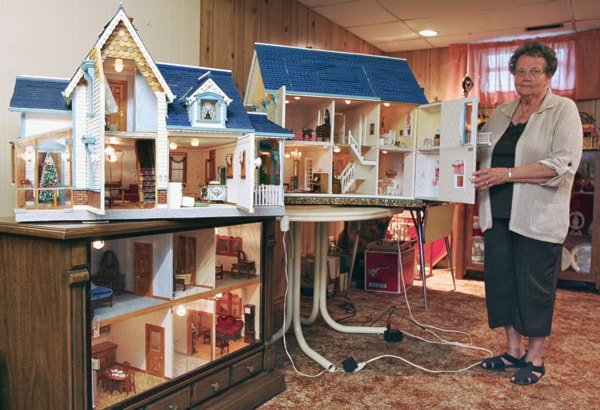The four custom-made doll houses were clearly a labour of love — from their tiny, hinged kitchen cabinet doors with brass or crystal knobs, to their pleated curtains and handmade furniture.
Since the late Helmut Lemke put so much of himself into each miniature creation he built, his family members decided the Red Deer Regional Health Foundation should benefit from the donation of four of his doll houses.
Before passing away in 2008, “my father had health situations that required trips and stays at the hospital,” recalled his daughter, Cheryl Brown.
“Just the fact that (Red Deer hospital) is so close and so good, and that so many people benefit from the foundation, it seemed appropriate.”
Brown, along with her sister, Joanne Lemke, and their mother, Marion Lemke, are giving away four of the 12 doll houses that Helmut built to help the foundation raise money during the Festival of Trees fundraiser this November.
“We’re very honoured” by the gesture, said the foundation’s project officer, Alaine Martin, who believes the donated houses will probably be auctioned, raffled or possibly sold during the dad and daughter event.
“It’s touching, seeing how much they’ve put into these doll houses, that they’re able to part with them,” added Martin.
“It must have been such a big decision.”
Brown admitted it was an emotional one for her family.
Helmut began building the intricate homes in the mid-1990s after retiring from farming. Brown recalled that her mom had showed her dad some plans for a doll house and he was intrigued enough to draft his own blueprints for his first one.
The Red Deer resident continued designing, building and furnishing doll homes to 2005. Marion helped with decorating decisions, including wallpaper, curtains and bedding.
Brown recalled the small-scale projects started out in the garage and ended up taking up a whole room of her parents’ house, as well as the kitchen table at times.
They involved trial and error and required specialized tools, such as a tiny table saw with a 4.5 cm blade that Helmut tracked down and paid $500 for in the early ’90s.
Although Helmut, a stickler for details, created some of the tiny furniture, he and Marion also regularly visited specialty stores in Edmonton and Calgary for chairs, tables, crystal chandeliers and lamps (the houses have electricity). Dishes and other household bric-a-brac was sometimes ordered from the U.S.
Each doll house took the couple about a year to finish, said Brown, who recalled the miniature dwellings became more and more elaborate over the years — culminating in a “spectacular” three-storey, wood-shingled house that she agreed to always keep in the family.
But this meant making the difficult decision to give away the two-storey doll house that her father had originally built for her. Two of the other donated doll houses are also two-storeys.
As well, the family is donating a unique house that Helmut designed within the wooden console of a 1980s television set. It has Plexiglass doors that slide open.
“People have told us they should be in a museum,” said Marion, “but we thought donating some of them to benefit the hospital would be the best way to honour (Helmut) and give back. On many occasions we have needed the hospital, and it has served us well.”
The Lemke family still has six doll houses, after selling one to the Ponoka Health Unit for home safety demonstrations, and donating a previous one to charity.
lmichelin@www.reddeeradvocate.com
